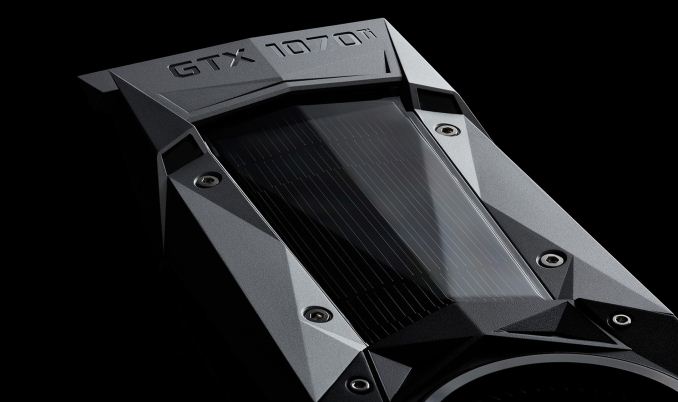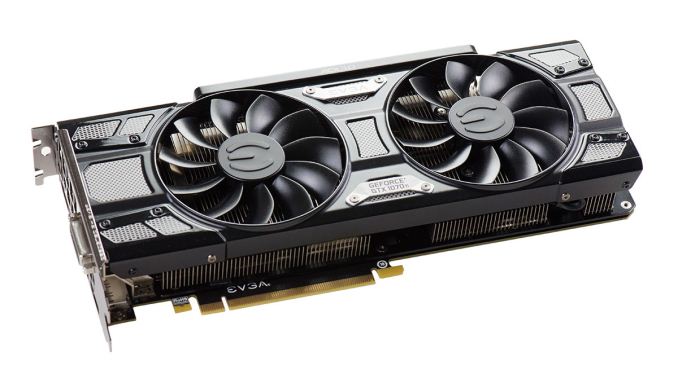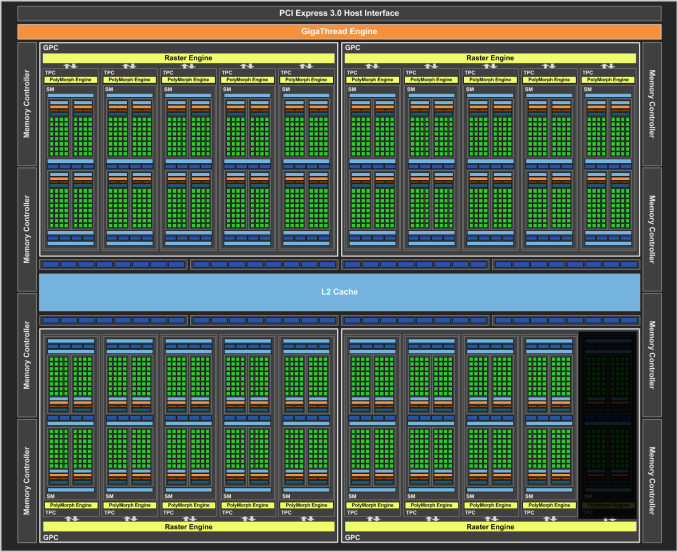NVIDIA Unveils GeForce GTX 1070 Ti: $449, Available for Preorders Today
by Nate Oh on October 26, 2017 10:45 AM EST- Posted in
- GPUs
- GeForce
- NVIDIA
- Pascal
- GTX 1070 Ti

This morning, NVIDIA is finally unveiling the speculation-consumed open secret that is the GeForce GTX 1070 Ti. Based on the same GP104 GPU as its GTX 1080 and 1070 siblings, this Pascal-based card comes late in the year, with NVIDIA’s last major consumer card launch in March (GTX 1080 Ti). While the card is not shipping until November 2nd, it is available for preorders from a number of retailers and system builders.
Going right to the specifications, the GTX 1070 Ti truly is a blend of the GTX 1080 and 1070, having only 128 fewer CUDA cores than the GTX 1080, a GTX 1080-like core clock and a GTX 1070-like boost clock, and 8GB of GDDR5 rather than GDDR5X. It appears that this is a new derivative of GP104, which outside of desktop GeForce also comes as a 2048 CUDA core GTX 1070 (Notebook) and 1792 CUDA core Quadro P4000.
| NVIDIA GPU Specification Comparison | |||||
| GTX 1080 | GTX 1070 Ti | GTX 1070 | |||
| CUDA Cores | 2560 | 2432 | 1920 | ||
| Texture Units | 160 | 152 | 120 | ||
| ROPs | 64 | 64 | 64 | ||
| Core Clock | 1607MHz | 1607MHz | 1506MHz | ||
| Boost Clock | 1733MHz | 1683MHz | 1683MHz | ||
| Memory Clock | 10Gbps GDDR5X | 8Gbps GDDR5 | 8Gbps GDDR5 | ||
| Memory Bus Width | 256-bit | 256-bit | 256-bit | ||
| VRAM | 8GB | 8GB | 8GB | ||
| FP64 | 1/32 | 1/32 | 1/32 | ||
| TDP | 180W | 180W | 150W | ||
| GPU | GP104 | GP104 | GP104 | ||
| Transistor Count | 7.2B | 7.2B | 7.2B | ||
| Manufacturing Process | TSMC 16nm | TSMC 16nm | TSMC 16nm | ||
| Launch Date | 05/27/2016 | 11/02/2017 | 06/10/2016 | ||
| Launch Price | MSRP: $599 Founders: $699 |
MSRP: $449 Founders: $449 |
MSRP: $379 Founders: $449 |
||
The GTX 1070 Ti represents a tier not present in recent NVIDIA generations, not just in terms of performance but also in terms of timing. The company has very rarely offered a 3 card stack based on the Gx104 GPU - we'd have to go back to the GeForce 600 series for that - and even less often with all 3 cards performing this close together. For the closest parallel we'd probably have to go back to the GeForce GTX 560 Ti w/448 Cores, a similar later-cycle product released near the end of the Fermi generation.
In any case, the GTX 1070 Ti is the most significant enthusiast video card launch from NVIDIA since 2016. GTX 1080 and 1070 were launched in May and June of 2016, with a mild refresh in the form of partner GTX 1080 11Gbps this May. So this is the first new video card NVIDIA has launched into this range in 16 months.
The million dollar question of course is "why now?" and while NVIDIA hasn't said anything about the product - in fact they haven't even briefed the press ahead of today's announcement - the obvious X factor right now is AMD. Specifically, AMD’s release of RX Vega64 and Vega56, launched on August 14th and 28th respectively. At launch, AMD chose to target the GTX 1080 and 1070 as the main competitor cards, and by some metrics the RX Vega cards may provide better value. Of the two, RX Vega56 in certain cases can even creep up to near-GTX 1080 performance. With the GTX 1070 Ti, NVIDIA and its partners have a chance to split the difference while taking advantage of the pre-existing GTX 1080 and 1070 board designs and cooling solutions.
Meanwhile I suspect that chip yields may also play a part. NVIDIA has gained the benefit of 16 months of yield improvements over at TSMC, reaching the point where they've moved on to things like fabbing the massive GV100 GPU on TSMC's 12nm process. So after this long, it may be that NVIDIA is seeing fewer GP104 GPUs with multiple defective SMs.
Otherwise the wildcard factor in the mix is cryptocurrency mining demand, which first affected RX 480 and GTX 1060 supply before engulfing the GTX 1070 for a time. Considering that GDDR5X does not provide as much mining value as GDDR5, the GTX 1070 was NVIDIA's fastest card for mining up until now. However on the flip side of the equation is that current popular cryptocurrencies (e.g. Ethereum) are far more bandwidth sensitive than compute sensitive - being intentionally designed to require large amounts of bandwidth to be ASIC-resistant - so the GTX 1070 Ti will likely be little-to-no faster at the task than the GTX 1070. In which case it will be interesting to see how miners (and the broader market) respond.
In terms of performance, the very limited material NVIDIA has put out on the card is promoting a roughly 15% performance improvement over the GTX 1070. Based on what we've seen with the Pascal architecture thus far, this seems reasonable given the specifications. The extra 4 SMs mean that even if GTX 1070 Ti's clocks are in practice identical to GTX 1070s - and with a higher TDP, I suspect we're going to see GTX 1070 Ti boost a bit better - means that this newer card has 26% more shading, texturing, and geometry resources than GTX 1070, which is a not-insignificant increase. However this is balanced against the fact that there's been no equivalent increase in memory bandwidth or rasterizer/ROP throughput. Games that hit the memory or ROPs especially hard will likely not see the same kind of benefit as compute-bound games.
The risk for NVIDIA here is that by minting a new SKU so close to the GTX 1080, they're playing with fire in terms of how much performance separates the cards. Typically the GTX 1070 trails the GTX 1080 by 20% or so. If we take NVIDIA's figures as a reasonable, typical scenario, then the GTX 1070 Ti is going to trail the GTX 1080 by only 8% or so, which is a rather thin margin for a typical GPU product stack. GTX 1080 is still the better card (especially when you're memory bandwidth bound), but GTX 1070 Ti will probably cannibalize GTX 1080 a bit.
I suppose the one drawback for the GTX 1070 Ti is that, on paper, energy efficiency is taking a minor hit. The card has the GTX 1080's 180W TDP, but not its entire performance. So relative to either the GTX 1080 or GTX 1070, the GTX 1070 Ti won't be Pascal with its best foot forward, but still quite fast for the price. And with the higher TDP, despite the fact that the official boost clock is identical to the GTX 1070, I would be surprised if the GTX 1070 Ti didn't boost a bit higher.
Moving on, let's talk about the launch lineup and the competitive landscape. The GTX 1070 Ti will be launching a week from now, on Thursday, November 2nd, with pre-orders starting today. This is going to be a combined reference and custom launch; NVIDIA has built a GTX 1070 Ti Founders Edition model, and their partners will have their own custom cards ready to go for next week's launch as well. Since this is using the existing GP104 GPU, partners can easily take their existing GTX 1080 designs and retool them for use on the TDP-identical GTX 1070 Ti.

EVGA's GeForce GTX 1070 Ti SC GAMING Black Edition
Pricing is a bit more interesting, however. Marking an odd departure from NVIDIA's other Pascal cards, NVIDIA isn't setting separate prices for vendor cards and the Founders Edition card, which was the case for 1080/1070/1060. Instead there is just a single MSRP: $449, which is what the Founders Edition card is priced at, and is where partner cards are starting. To date, NVIDIA has been charging a premium for the FE cards, and that is going away. This is going to have interesting ramifications for the partner ecosystem, but we'll save that for the review.
As for the competitive landscape, competing with NVIDIA's newest card is of course AMD's Vega lineup. Based on current prices, the GTX 1070 Ti will be going up squarely against the Vega 56. Considering that Vega 56 holds an 8% lead over the vanilla GTX 1070, it's easy to see how NVIDIA and its partners are looking to make sure that there's no point where AMD has the faster card. That said, in terms of gaming competition the RX Vega cards have not been exerting significant pressure on NVIDIA’s high-end 10-series cards as it is, at least to the extent that the previous generation R9 Fury cards put on the GTX 980 and 980 Ti. Pricing and availability are a big factor here on both sides, and until recently it's been difficult for AMD encroach on NVIDIA's position.
Overall then, what the GTX 1070 Ti does do competitively, besides performance of course, is target the current external weaknesses of RX Vega: suboptimal availability and pricing, as well as the lack of AIB partner cards. At the expense of segmenting NVIDIA’s graphics lineup further, the GTX 1070 Ti also allows room to maneuver for an eventual Vega 11 based card. Additionally, considering that variable sync monitors tend to be matched with high-end cards and vice versa, the market impact could extend into FreeSync and G-Sync ecosystems.
The GTX 1070 Ti is available for preorder today from retailers as well as boutique system builders such as Origin PC. More information and details can be found on NVIDIA’s product page and news post.
| Fall 2017 GPU Pricing Comparison (Still Crypto-Crazy Edition) | |||||
| AMD | Price | NVIDIA | |||
| Radeon RX Vega 64 | $569 | ||||
| $509 | GeForce GTX 1080 | ||||
| Radeon RX Vega 56 | $469/$449 | GeForce GTX 1070 Ti | |||
| $409 | GeForce GTX 1070 | ||||
| Radeon RX 580 (8GB) | $299 | ||||
| $259 | GeForce GTX 1060 (6GB) | ||||
Source: NVIDIA












38 Comments
View All Comments
willis936 - Thursday, October 26, 2017 - link
So basically a 1080 without G5X? I'm amazed how many markets have been dominated by DRAM price this year. When will supply catch up to demand?T1beriu - Monday, October 30, 2017 - link
You missed the point.Golgatha777 - Thursday, October 26, 2017 - link
I feel like if you're in the market for a $500 graphics card, you'll pay 10% more for 8% more performance and mature drivers, but that's must my opinion.Golgatha777 - Thursday, October 26, 2017 - link
That said, if your goal is to beat the competition at their own price point, this does it.CaedenV - Thursday, October 26, 2017 - link
10% more by MSRP price... but most 1080 cards are coming in closer to $550-700 range.If these really do "only" cost $450 then they will be a very good deal
Shlong - Thursday, October 26, 2017 - link
Back when I was getting ready to build my Ryzen system in March, I found an open box GTX 1080 for $420 at Microcenter. It overclocks well and so glad I was there at the right time.AlishaScott - Sunday, October 29, 2017 - link
I just got paid $6784 working off my laptop this month. And if you think that’s cool, my divorced friend has twin toddlers and made over $9k her first month. It feels so good making so much money when other people have to work for so much less. This is what I do... http://cutt.us/O5gexlimitedaccess - Thursday, October 26, 2017 - link
Was it mentioned in the material so far whether or not the Founder Edition will be using the GTX 1080s vapor chamber heat sink or the GTX 1070s pressed heat pipe heat sink?Ryan Smith - Thursday, October 26, 2017 - link
No, it was not mentioned.soliloquist - Thursday, October 26, 2017 - link
I too am interested in the answer to this question. Given the same 180W TDP as the GTX 1080 you would think it has the same cooling solution, but you never know.